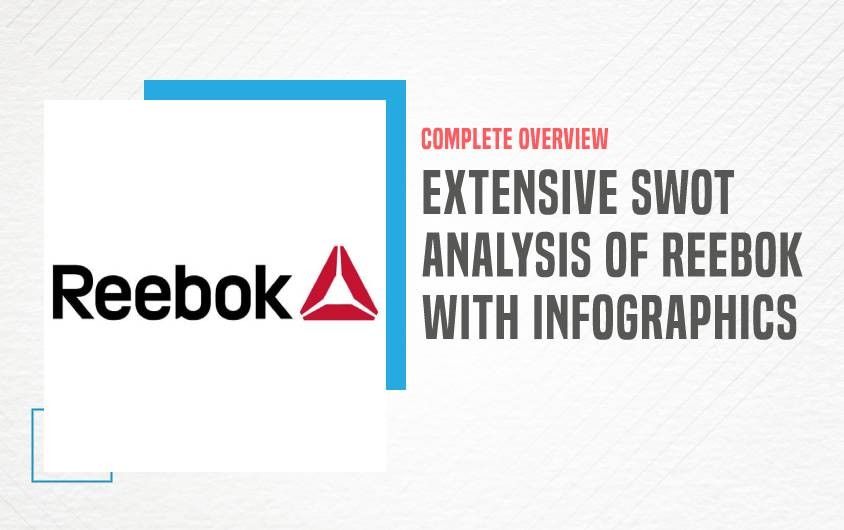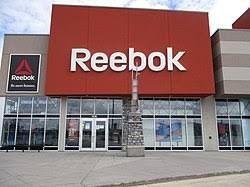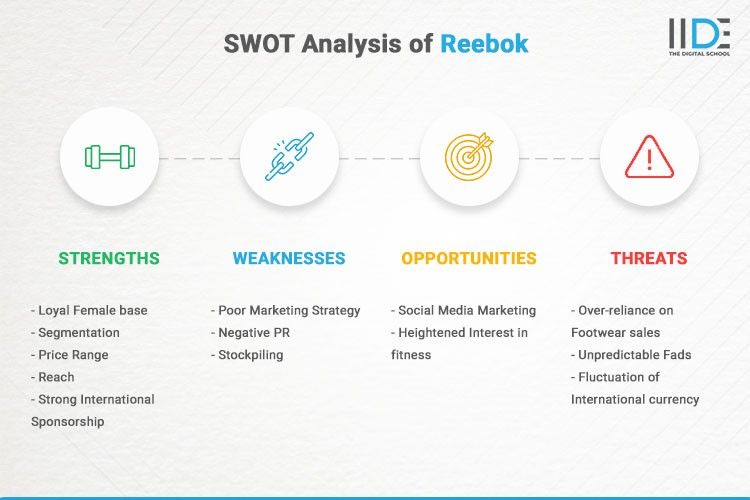Students Centric
Placements Report
Trackable results, real numbers
Reviews
Proven success, real voices
Trainers
Expert-led, Industry-Driven Training
Life at IIDE
Vibrant Spirit student life
Alumni
Successful Journeys, Inspiring Stories
Learning Centre
Webinars
Blogs
Case studies
Live, Interactive Masterclasses
Fresh Insights, quick reads
Real-life, Industry relevant
More
Hire from us
Hire Top Digital Marketing Talent
Work with us
Join Our Team, Make an Impact
Customised Training
Personalised digital marketing training for your company
Refer & earn
Simple, easy rewards
Contact us
Get the answers you need
About us
Know more about IIDE
Explore all course options
Trending
Professional Certification in AI Strategy
- Ideal for AI Enthusiast

Updated on Dec 12, 2025
Previously we looked into the Marketing Mix of Adidas, a globally leading sportswear brand and parent of Reebok. This time, we will tackle the SWOT Analysis of Reebok.
Reebok is an American-inspired global brand that is all about fashionable fitness. The majority of the American market was not controlled by Nike or Adidas. They pride themselves on being a company that ushered in a fitness craze that permanently altered the way society views sportswear. Reebok has evolved from a typical sports brand to a fitness-focused brand.
Marketing is a growing concept that evolves with the trends and interests of current consumers. Reebok’s effective marketing methods have helped them reach global markets while positioning itself as one of the leading sportswear brands. Digital media is used in the majority of effective campaigns. Check out our Free MasterClass on Digital Marketing 101, delivered by Karan Shah, CEO and Founder of IIDE, if you want to learn more about today’s effective marketing.
Before we proceed with the SWOT Analysis of Reebok, let’s learn about the company, its founding, financial status, products and competitors.
About Reebok
It all began in England, in 1958, by a sibling duo – Joseph and Jeff Foster, who aimed to carry on their family tradition of making athletic footwear. Reebok was then a subdivision of the family’s already existing footwear company. Today they have grown into one of the largest sportswear brands that not only sell footwear but expanded to CrossFit clothing, equipment and more.

In 1979, Paul B. Fireman, a marketer of camping and fishing gear, spotted the wares of a tiny British sports shoemaker, Reebok International, at a Chicago sporting goods exhibition and decided to buy them. In search of a commercial opportunity, Fireman purchased the company’s North American licence and thus began the reign of Reebok U.S.A.
Reebok was then purchased by Adidas in 2005 in an attempt by the German business to create a double assault on Nike. The conventional thinking of the time led both shoe firms to assume that by joining forces, they might oust the number one sneaker producer and seize the top spot.
| Founder | Joseph William Foster |
|---|---|
| Year Founded | 1985 |
| Origin | Lancashire, England |
| No. of Employees | 4,967 |
| Company Type | Subsidiary | Parent – Adidas |
| Market Cap | Adidas | €58 Billion (2020) |
| Annual Revenue | €1.41 Billion (2020) |
| Net Profit | Adidas | €674 Billion (20201) |
Products of Reebok
Reebok has successfully risen in the sportswear market by selling the following –
- Clothing
- Footwears
- Fitness Equipment
- Fitness Accessories (Backpacks, watches, sunglasses, etc)
Competitors of Reebok
In the athletics fashion sector, there are a plethora of options. These are Reebok’s major competitors –
- Nike
- Adidas
- Puma
- Under Armour
- Hanesbrands
Now that we have tackled the areas that give us insight into the company’s core operations, let’s look into the SWOT Analysis of Reebok.
SWOT Analysis of Reebok

An organization’s internal strengths and weaknesses, as well as external opportunities and dangers, are identified through research that is done through the SWOT Analysis.
1. Strengths of Reebok
Let’s start with the S of SWOT analysis of Reebok i.e. Strength. These are termed as the internal factors that helped Reebok maintain its top position.
- Loyal Female base – In 1979, Reebok introduced the Aztec princess which happened to be their stepping stone to the US market. When no one was thinking about Women’s sports shoes, Reebok became the first brand to release Women athletic shoes. Since then Reebok has never let their targeted women audience down, creating a loyal female base.
- Segmentation – Reebok manufactured products for specific sports usage and categorised it to specific segments. This creates the brand image of creating products that cater to specific audiences – meeting demands.
- Price range – They aim to sell products at an average price, making their goods accessible to the middle-class. This gave the customers an option to utilise high-quality products. Other competitors don’t reach this market as their starting price of products belongs to the luxury category.
- Global Reach – In 1990, Reebok did business in only 45 countries, but it jumped to 140 countries in 1992, just 2 years. Reebok now sells its products worldwide. Through a Multi-Channel distribution strategy, Reebok can reach a larger customer base and satisfy the customer.
- Strong International Sponsorship – UFC and Spartan Race officially have a sponsorship deal in Apparel and Footwear with Reebok. The company has a stronghold on Hockey, Football, and Baseball sponsorships, globally. Moreover, they sponsored influential players in the NFL, UFC and NBA as well.
2. Weakness of Reebok
The next part of the SWOT analysis of Reebok is its Weakness. Let’s see the Weaknesses of Reebok which give Reebok a disadvantage in some or the other way!
- Poor Marketing Strategy – Reebok’s shortcoming in marketing is its main weakness. While other athletic shoe manufacturers are promoting their product lines, Reebok is not and remains out of constant reach with their customers.
- Negative PR – Any negative controversy affects the Brand image. In 2017, CrossFit said Reebok was dishonest and fraudulent, claiming $4.8 million in breach of contract. Another major controversy was an ad campaign in Germany asking gym-goers to cheat on their girlfriend instead of exercising. These kinds of controversies create a strained relationship between the brand and the customer – creating a negative brand value.

Reebok’s Controversial Ad was then removed.
- Stockpiling – The future growth of the company’s five brands is about 9.5% in dollar terms. This growth is alarming. Reebok should be careful as retailers may order more than they can sell. This could lead to a sudden drop in orders, resulting in more inventory and lower revenues for the company.
3. Opportunities for Reebok
Now we will analyze the O of SWOT analysis of Reebok. Here, We will understand what all opportunities will give Reebok a competitive advantage. Opportunities are the external factors that give a company a favourable condition to achieve its goal.
- Social Media Marketing – Social Media is now a prime location for Marketing, After Sales service, Customer services, Customer communication, and many more. To be in the spotlight or on the top of the customer’s mind it needs to be active on Social Media. Their lack of a strong presence and strategy in the digital sphere of marketing is a setback.
- Heightened Interest in fitness – Due to Covid-19, the movement around the world stopped due to quarantine. This created a lethargic environment. However, the fitness geeks and gradually the whole of society began looking out for home work-out options.
4. Threats to Reebok
Let’s see the Threats which are the external factors that have an unfavourable impact on Reebok! This is the last part of the SWOT analysis of Reebok.
- Over-reliance on Footwear sales – Footwear is Reebok’s largest division and therefore the company depends fairly heavily on the footwear market. Reebok had also to bear in mind that the marketplace for costlier footwear was slowing. This might ultimately force costs down, ought to this trend will continue for a major amount of time. The corporation was so dependent on footwear that it risked losses, whereas other competitors resembling Nike will fall back on their attire division.
- Unpredictable Fads – It implies that economic processes are unpredictable. E.g., client tastes for garments change frequently. Thus, the style business suffers an excellent uncertainty. The style may live for a few days or even years. The fads are unpredictable and pose a threat.
- Fluctuation of International currency – A depreciation of the local currency increases the cost of imports of goods, which can reduce the volume of imports Domestic companies will benefit from increased sales, profits and employment.
For large global brands like Reebok, a SWOT Analysis is a good approach to break down their operations and analyse management risks and benefits. With this, the SWOT Analysis of Reebok comes to an end.


Learn Digital Marketing for FREE
- 45 Mins Masterclass
- Watch Anytime, Anywhere
- 1,00,000+ Students Enrolled


Conclusion
Reebok has created a loyal base since its inception in the 1950s. They focused on an audience that was not addressed – Women sports, which put them in the spotlight. Reebok has also worked to make its products available for averaged income households, thus expanding their reach.
Reebok has suffered many times due to failed advertising stunts but has come up strong with great innovations in the sports market and stayed at the top. They successfully captured the American market, hence, they should widen their horizons and split their focus on the other global markets.
Reebok uses multiple channels of digital marketing such as SEO, Emailing and Content Marketing to promote and educate its clients about newer products. However, they have the scope to expand and take advantage of the benefits of Digital Marketing because of its cost-effectiveness and connectivity with customers all over the world.
Gaining accurate knowledge on the strategies and functions of Digital Marketing is important, to work with renowned brands like Reebok and Completing Certified Courses may present you with that opportunity.
IIDE offers training in certain Digital Skills and expertise, and Short Term Certification Courses may get you up to speed in just 5 days. Check out IIDE’s short-term certification courses include courses on Social Media Marketing, Media Planning, Search Engine Optimization and more.
If you like such in-depth analysis of companies, find more such insightful case studies on our IIDE Knowledge portal.
Thank you for taking the time to read this case study, and do share your thoughts in the comments section below.
Want to Know Why 2,50,000+ Students Trust Us?
Dive into the numbers that make us the #1 choice for career success

Courses Recommended for you
MBA - Level
Post Graduate in Digital Marketing & Strategy
Best For
Fresh Graduates
Mode of Learning
On Campus (Mumbai & Delhi)
Starts from
Jan 5, 2026
Duration
11 Months
Live & Online
Advanced Online Digital Marketing Course
Best For
Working Professionals
Mode of Learning
Online
Starts from
Jan 5, 2026
Duration
4-6 Months

Online
Professional Certification in AI Strategy
Best For
AI Enthusiasts
Mode of Learning
Online
Duration
5 Months

Offline
Undergraduate Program in Digital Business & Entrepreneurship
Best For
12th Passouts
Mode of Learning
On Campus (Mumbai)
Duration
3 Years
Recent Post
- Bosch 2025: Strategic Insights into Market Position, Challenges, and Growth Opportunities
- Nasher Miles Marketing Strategy 2025: A Journey from Trolleys to Trendsetters
- Beco Marketing Strategy 2025: Leading India’s Eco-Friendly Revolution
- P-TAL Marketing Case Study: Reviving India’s Timeless Craftsmanship
- Marketing Case Study: Rocca - Rising Above the Chocolate Crowd in India
- Unveiling What's Up Wellness Marketing Strategy: Key Tactics and Insights
- Lenskart Marketing Strategy 2025: AI, Content & Omni-Channel Success
- Ruban's Jewelry Marketing Strategy for Crafting Timeless Success in the Luxury Market
- Decoding iMumz’s Marketing Playbook: A Wellness Brand Built on Empathy
- Nish Hair Marketing Strategy: The Complete AIDA Playbook for D2C Success
Author's Note:
I’m Aditya Shastri, and this case study has been created with the support of my students from IIDE's digital marketing courses.
The practical assignments, case studies, and simulations completed by the students in these courses have been crucial in shaping the insights presented here.
If you found this case study helpful, feel free to leave a comment below.
Aditya Shastri leads the Business Development segment at IIDE and is a seasoned Content Marketing expert. With over a decade of experience, Aditya has trained more than 20,000 students and professionals in digital marketing, collaborating with prestigious institutions and corporations such as Jet Airways, Godrej Professionals, Pfizer, Mahindra Group, Publicis Worldwide, and many others. His ability to simplify complex marketing concepts, combined with his engaging teaching style, has earned him widespread admiration from students and professionals alike.
Aditya has spearheaded IIDE’s B2B growth, forging partnerships with over 40 higher education institutions across India to upskill students in digital marketing and business skills. As a visiting faculty member at top institutions like IIT Bhilai, Mithibai College, Amity University, and SRCC, he continues to influence the next generation of marketers.
Apart from his marketing expertise, Aditya is also a spiritual speaker, often traveling internationally to share insights on spirituality. His unique blend of digital marketing proficiency and spiritual wisdom makes him a highly respected figure in both fields.